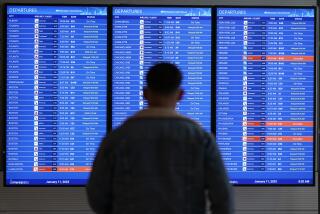Recovery in Sight for Airlines
- Share via
The airline business, flat on its back a year ago amid staggering losses, is slowly starting to recover.
The latest evidence came Wednesday when American Airlines parent AMR Corp. said it eked out a $1-million profit in the third quarter. Reflecting heavy summer flying and massive cost cutting by the carrier, it broke a string of 10 losing quarters for the world’s largest airline.
A year earlier, AMR had lost nearly $1 billion in the quarter.
The industry as a whole lost $18 billion over the last two years. US Airways Group Inc. went through a bankruptcy reorganization, and UAL Corp.’s United Airlines is operating under Chapter 11 of the bankruptcy laws.
But in this year’s third quarter, several airlines finished in the black. They included big network carriers such as AMR, Northwest Airlines Corp. and Continental Airlines Inc., and several low-cost carriers that already had been profitable, such as Southwest Airlines Inc. and AirTran. Another low-fare carrier, JetBlue Airways Corp., is expected to report a third-quarter profit today.
Airline stocks rallied as investors anticipated the rebound. The American Stock Exchange’s index of airline stocks has soared 73% since April 30.
To be sure, the industry faces rough flying ahead. The next two quarters -- the fourth and first -- are typically weak for the airlines, as passenger traffic drops. And the carriers remain laden with debt. Large airlines such as American also are struggling to wring higher fares from price-conscious business and leisure travelers who are flocking to the discount airlines.
“We are generating momentum,” Gerard Arpey, AMR’s chief executive, said in a conference call with analysts and the media. “But we’re mindful of the fact that we’re headed into the more difficult fall and winter seasons.”
Business travel remains soft, Arpey added, although a trade group said it should pick up next year. The Travel Industry Assn. of America estimated that U.S. business trips of all kinds would rise 4.2% in 2004, its first annual gain since 1999.
The airlines are looking at enormous costs. Robert Mann, president of the consulting firm R.W. Mann & Co., estimates that pension contributions, capital spending and debt payments will cost the industry $35 billion over the next three to four years.
Most carriers “on balance ... appear to have stabilized,” Mann said. “But that’s a long way from being healthy.”
AMR’s third-quarter profit, which amounted to a break-even performance on a per-share basis, contrasted with a year-earlier loss of $924 million. Its quarterly revenue edged up 2% to $4.6 billion.
The Fort Worth-based airline said the latest quarter included several one-time gains and charges which, if excluded, left AMR with a pretax operating loss of $23 million, or 15 cents a share. On that basis, analysts surveyed by Thomson First Call had expected AMR to report a much deeper loss of 41 cents a share.
Some investors had hoped that AMR would turn a profit on that basis as well, and their disappointment was a key reason AMR’s stock tumbled $1.24 to $13.66 Wednesday on the New York Stock Exchange.
Still, AMR’s small profit represented a notable rebound for the airline just six months after it nearly filed for bankruptcy protection and its former chief executive, Donald J. Carty, resigned under pressure.
Carty was replaced by Arpey after AMR management hid executive perks from the airline’s workers at the same time the employees were being pressed to accept $1.8 billion in annual wage cuts and other concessions.
The concessions ultimately were accepted, and they’ve played a major role in AMR’s recovery. In the latest quarter, its labor costs dropped 20% from a year earlier, to $1.7 billion from $2.1 billion.
In early 2001, the airlines already were weakening with the economy’s downturn, and then they were decimated when the Sept. 11 terrorist attacks sent travel into a nose dive.
The industry secured a $5-billion cash bailout from the U.S. government, and more than 80,000 airline workers lost their jobs -- 35,000 at American Airlines alone. But most carriers continued to bleed red ink well into this year.
The hardest hit were the network airlines such as American and United, which had much higher operating costs than the discount carriers. At the same time, those airlines found they could no longer sell as many high-fare seats to business travelers, who were increasingly shopping for cheaper prices or not flying at all.
UAL reports its third-quarter results Oct. 30.
More to Read
Inside the business of entertainment
The Wide Shot brings you news, analysis and insights on everything from streaming wars to production — and what it all means for the future.
You may occasionally receive promotional content from the Los Angeles Times.











